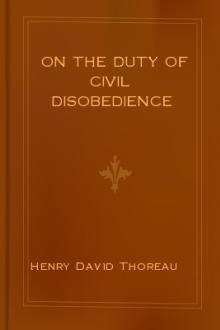Essays - Henry David Thoreau (best e reader for android .TXT) 📗

- Author: Henry David Thoreau
Book online «Essays - Henry David Thoreau (best e reader for android .TXT) 📗». Author Henry David Thoreau
Though there was but this single road, it was a continuous village for as far as we walked this day and the next, or about thirty miles down the river, the houses being as near together all the way as in the middle of one of our smallest straggling country villages, and we could never tell by their number when we were on the skirts of a parish, for the road never ran through the fields or woods. We were told that it was just six miles from one parish church to another. I thought that we saw every house in Ange Gardien. Therefore, as it was a muddy day, we never got out of the mud, nor out of the village, unless we got over the fence; then indeed, if it was on the north side, we were out of the civilized world. There were sometimes a few more houses near the church, it is true, but we had only to go a quarter of a mile from the road to the top of the bank to find ourselves on the verge of the uninhabited, and, for the most part, unexplored wilderness stretching toward Hudson’s Bay. The farms accordingly were extremely long and narrow, each having a frontage on the river. Bouchette accounts for this peculiar manner of laying out a village by referring to “the social character of the Canadian peasant, who is singularly fond of neighborhood,” also to the advantage arising from a concentration of strength in Indian times. Each farm, called terre, he says, is, in nine cases out of ten, three arpents wide by thirty deep, that is, very nearly thirty-five by three hundred and forty-nine of our rods; sometimes one half arpent by thirty, or one to sixty; sometimes, in fact, a few yards by half a mile. Of course it costs more for fences. A remarkable difference between the Canadian and the New England character appears from the fact that in 1745, the French government were obliged to pass a law forbidding the farmers or censitaires building on land less than one and a half arpents front by thirty or forty deep, under a certain penalty, in order to compel emigration, and bring the seigneur’s estates all under cultivation; and it is thought that they have now less reluctance to leave the paternal roof than formerly, “removing beyond the sight of the parish spire, or the sound of the parish bell.” But I find that in the previous or seventeenth century, the complaint, often renewed, was of a totally opposite character, namely, that the inhabitants dispersed and exposed themselves to the Iroquois. Accordingly, about 1664, the king was obliged to order that “they should make no more clearings except one next to another, and that they should reduce their parishes to the form of the parishes in France as much as possible.” The Canadians of those days, at least, possessed a roving spirit of adventure which carried them further, in exposure to hardship and danger, than ever the New England colonist went, and led them, though not to clear and colonize the wilderness, yet to range over it as coureurs de bois, or runners of the woods, or as Hontan prefers to call them coureurs de risques, runners of risks; to say nothing of their enterprising priesthood; and Charlevoix thinks that if the authorities had taken the right steps to prevent





Comments (0)